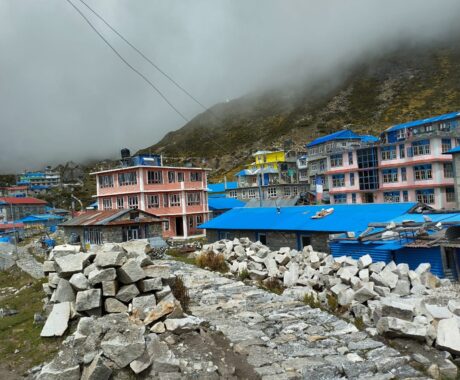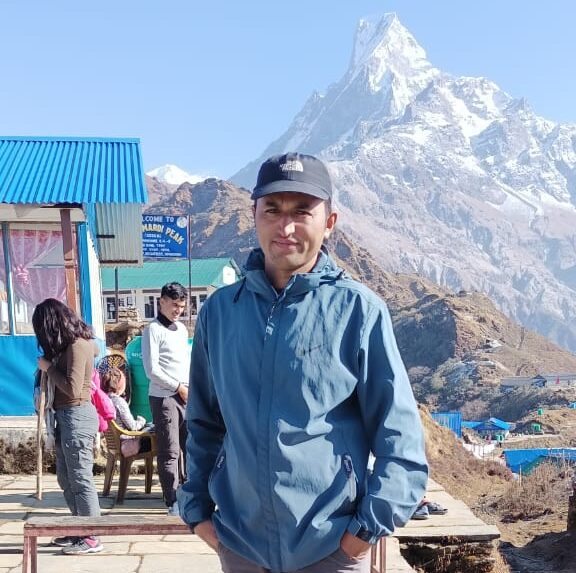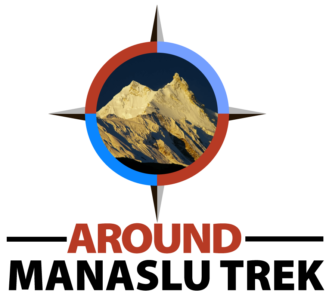Kanchenjunga North Base Camp Trek
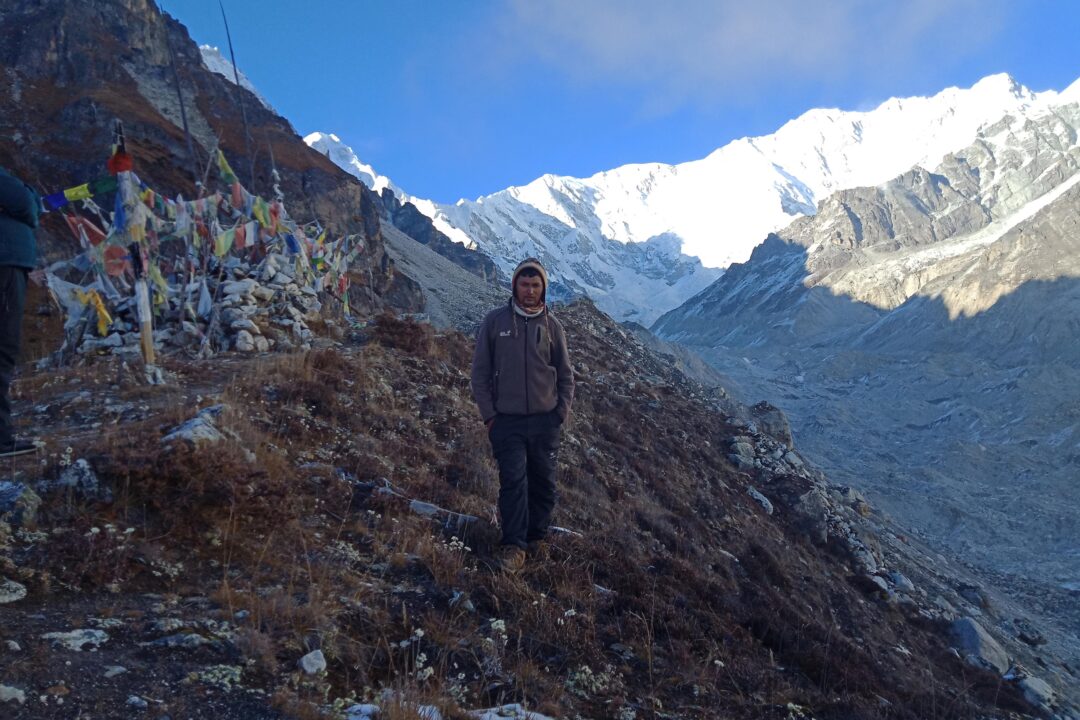
Trip Facts
- Destination Kanchenjunga Region Nepal
- Activity Trekking
- Duration 15 Days
- Trip Difficulty moderate_strenuous
- Max. Altitude 5200m
- Best Time Sep to Dec & March to May
- Start and End Kathmandu - Kathmandu
- Meals Breakfast / Lunch / Dinner
- Accommodation 3 star hotel in Kathmandu &Tea house
- Group Size 2 - 15
- Transportation Private tasport & Kathmandu to Suketar round trip flight ticket
Trip Highlights
- Explore the less traversed Eastern mountainous regions of Nepal
- Walk past the popular glacial lakes in the region
- Amazing time walking through the diverse flora and fauna
- Meditate in Ramtang and Oktang Monasteries after your tiring walks
- Have an amazing time resting on your tents on the lap of the giant peaks
- Wild trekking
- Red panda ,Snowlepord and Bear zoon
Introduction
First ascended on May 25, 1955, by the British expedition team led by G. Band and J. Brown, Kanchenjunga remains an irresistible lure for adventurers worldwide. Its name, translated as the “Five Treasures of Snow,” reflects the majesty of its five peaks, each one a treasure of its own: Kanchenjunga Main, Kanchenjunga West (Yalungkhang), Kanchenjunga Center, Kanchenjunga South, and Khangbachen. Embark on this thrilling expedition as we journey through the diverse landscapes of eastern Nepal.
Kanchenjunga North Base Camp Trek
Starting from Kathmandu, we take a 1-hour flight to Suketar Taplejung. From here, we head north along the Tamor River, offering scenic views that are sure to leave you spellbound. It yourself in the rich cultural tapestry of this area, home to Hindu, Buddhist, and ethnic communities whose livelihoods are intricately tied to the land. As we trek through their villages, you’ll get a glimpse into their traditional way of life and unique customs. You’ll also have the opportunity to witness the abundant wildlife, including the elusive snow leopard, red panda, and an array of bird species. The Kanchenjunga trek is a journey of discovery and adventure, with a choice of routes to suit your preference. Whether you opt for the south base camp or a round trip encompassing both, we have you covered. Each trek offers a unique perspective on this majestic region, with trips varying from 15 days.
At RP Adventures, we believe in offering an immersive experience. We take care of all the necessary permits, Kanchenjunga Special Permits and Kanchenjunga Conversation permits and logistics, so all you need to do is soak in the breathtaking scenery and create lasting memories. Join us and let’s conquer Kanchenjunga together, experiencing the awe-inspiring allure of the Himalayas.
Day 01: Arrival in Kathmandu and pickup to hotel – 1,300m
Day 02: Kathmandu Day Sightseeing – 1,300m
Day 03: Fly From Kathmandu to Suketar – 01 hrs Drive to Ranipul – 04 hrs
Day 04: Trek to Amjilosa 2,300m – 06 hrs
Day 05: Trek to Gyabla 2,700m – 06 hrs
Day 06: Trek to Ghunsa 3,500m – 06 hrs
Day 07: Trek to Khangpachen 4,100m – 08 hrs
Day 08: Rest day in Khangpachen / Hike to Janu Base Camp 4500m – 04 hrs
Day 09: Trek to Lonakha 4,700m – 07 hrs
Day 10: Trek to Kanchenjunga North Base Camp Back to Lonakha 4,700m – 08 hrs
Day 11: Trek Back to Ghunsa 3,500m – 08 hrs
Day 12: Trek to Amjilosa 2,300m – 08 hrs
Day 13: Trek Back to Sekathum – 04hrs And Drive back to Suktar 2,600m – 04 hrs
Day 14: Fly from Suketar to Kathmandu 1,300m – 01 hrs
Day 15: Departure from Kathmandu Airport – 1,300m
Alternative Treks Around Kanchenjunga North Base Camp Trek
The Kanchenjunga North Base Camp Trek takes you to the foot of Mount Kanchenjunga (8,586m), the world’s third-highest peak. This trek is ideal for those seeking remote wilderness, rich cultural experiences, and stunning mountain scenery. If you’re looking for alternative treks in the Kanchenjunga region, here are some great options:
- Kanchenjunga South Base Camp Trek – 11 Days: Explore the southern side of Kanchenjunga, offering stunning views and a more accessible trek while still embracing the wilderness and cultural immersion.
- Kanchenjunga North Base Camp and Lumba Sumba – 29 Days: This longer trek takes you to both the north base camp of Kanchenjunga and the beautiful Lumba Sumba Pass, providing a challenging yet rewarding adventure.
- Kanchenjunga North and South Base Camp Trek – 22 Days: A comprehensive trek that covers both the North and South Base Camps of Kanchenjunga, offering an immersive experience of the mountain’s diverse landscapes and rich cultures.
Detailed Itinerary
-
Day 01: Arrival in Kathmandu, pickup to hotel - 1,300m
Altitude: 1300mMeals: BreakfastAccommodation: 3 star hotel in kathmandu -
Day 02: Kathmandu Day Sightseeing - 1,300m
Altitude: 1300mMeals: BreakfastAccommodation: 3 star hotel in Kathmandu -
Day 03: Fly From Kathmandu to Suketar - 01 hrs Drive to Ranipul - 04 hrs
After breakfast, our guide will collect you from your hotel and accompany you to the airport. The short flight to Suketar takes us over the Kathmandu Valley and surrounding hill and through some of the mountains Nepal is famous for. A free mountain flight! On arrival in Suketar., we will drive to Ranipulthe.
Altitude: 1400mMeals: Breakfast / lunch / DinnerAccommodation: Tea house -
Day 04: Trek to Amjilosa 2,300m - 06 hrs
Waterfalls and suspension bridges are part of today’s trail. Plus, we come to the first Sherpa village on our trek, where we stay overnight. The village of Amjilosa is mainly used during the time when the yaks and sheep are in the pastures, so very few families live here full time it is not a big village only 5 houses are there.
Altitude: 2300mMeals: Breakfast / lunch / DinnerAccommodation: Tea house -
Day 05: Trek to Gyabla 2,700m - 06 hrs
After breakfast, we head off through different forests of pine, bamboo, rhododendron, and oak. We notice the villages and people are becoming more Tibetan-like. We also see yaks, sheep, and goats on the trail, not to mention a good variety of birdlife. After lunch, the trail takes us up through dense forest cover and over a wooden bridge on to Gyabla, where we spend the night. This place is famous for bears and red pandas.
Altitude: 2700mMeals: Breakfast / lunch / DinnerAccommodation: Tea house -
Day 06: Trek to Ghunsa 3,500m - 06 hrs
Today the trail continues on through forests and passes Phale Village, which was a Tibetan refugee camp started decades ago when Tibetans started fleeing from the communist regime in China. Today it is a winter settlement village. We have time to visit the village where there are some handicrafts for sale. We head to Ghunsa, the largest village in the area and one with a police station, a health post, and a Kanchenjunga Conservation Office. Telephone and internet services are available here. On the ways we can see Red Panda Block A and Block B centers.
Altitude: 3500mMeals: Breakfast / lunch / DinnerAccommodation: Tea house -
Day 07: Trek to Khangpachen 4,100m - 08 hrs
We are now at a higher altitude and aiming to go higher! So we take the opportunity to relax and acclimatize in Ghunsa. There is a monastery to explore and a ridge to climb. From the ridge there are views of Jannu Peak, which is worth the 5 hours plus round trip. Should you wish to climb up the ridge-and we recommend this as it helps acclimatize our bodies-we will take a packed lunch with us. Views of the Jannu Himal dominate the skyline today. Following a gentle upward path we come to a green glacier valley. Here we may be lucky to spot blue sheep and snow leopards. The trail continues on past a waterfall to a landslide-prone area where we take particular care.
Altitude: 4100mMeals: Breakfast / lunch / DinnerAccommodation: Tea house -
Day 08: Rest day in Khangpachen .Hike to Janu Base Camp 4500m - 04 hrs
Again, we take the chance to acclimatize our bodies to the altitude in preparation for our visit to the North Base Camp. We can climb another ridge today where we get stunning views of Kanchenjunga.
Altitude: 4100mMeals: Breakfast / lunch / DinnerAccommodation: Tea house -
Day 09: Trek to Lonakha 4,700m - 07 hrs
Today the trail takes us mainly over moraine from the Kanchenjunga Glacier. Walking uphill over large boulders, there are wonderful views on both sides of us. And as we are deep in Snow Leopard territory, we keep our eyes open for this rare animal too! This is also an area of summer yak pastures, but there are no settlements on the route.
Altitude: 4700mMeals: Breakfast / lunch / DinnerAccommodation: Tea house -
Day 10: Trek to Kanchenjunga North Base Camp Back to Lonakha 4,700m - 08 hrs
After a good breakfast, we again set out across the moraine from the Kanchenjunga Glacier, gently climbing upwards. At Base Camp, we stand in awe of the surrounding mountains and drink up the atmosphere created by Buddhist prayer flags fluttering in the wind. We sit here for some time, enjoying the tranquility and a hot drink and snacks! We return to Lhonak for the night. We hiked more than 8 hours.
Altitude: 4700mMeals: Breakfast / lunch / DinnerAccommodation: Tea house -
Day 11: Trek Back to Ghunsa 3,500m - 08 hrs
Trekking over pebbles and moraine, we reach Kambachen Village for lunch before heading east along the Tamor River. Now the vegetation is greener as we again return to Ghunsa, where we spent the night.
Altitude: 3500mMeals: Breakfast / lunch / DinnerAccommodation: Tea house -
Day 12: Trek to Amjilosa 2,300m - 08 hrs
Altitude: 2300mMeals: Breakfast / lunch / DinnerAccommodation: Tea house -
Day 13: Trek Back to Sekathum .4hrs And Drive back to Suktar 2,600m - 04 hrs
Altitude: 2600mMeals: Breakfast / lunch / DinnerAccommodation: Tea house -
Day 14: Fly from Suketar to Kathmandu 1,300m - 01 hrs
Altitude: 1300mMeals: Breakfast / lunch / DinnerAccommodation: 3 star hotel in Kathmandu -
Day 15: Departure from Kathmandu Airport - 1,300m
Altitude: 1300mMeals: Breakfast
What's included
- International and Domestics Airport pick up and drop
- 3 star level hotel accommodation in Kathmandu (breakfast included)
- Tea house accommodation (twin-shared basis) in the trek
- Meals (Breakfast, Lunch, and Dinner) Tea ,Coffee during the trek
- Kathmandu to Taplejubg suketar airport Both ways
- A professional trekking guide
- A porter (carry up to 20kg ) - 1 porter for every 2 trekkers
- Meals, Accommodation, Travel Insurance etc for all our staffs during the trek
- All required permits Kanchenjunga special permits and Kanchenjunga Conversation area
- Basic medical kits
- A trekking map
- A duffel bag to carry all your belongings (should be returned after the trek)
- All Government taxes and VAT
- Farewell dinner
- RP Adventures T-shirt
What's not included
- International Airfares
- Travel Insurance
- Nepal Visa fee
- Lunch and Dinner in Kathmandu
- Tips for Guide , Porter
- Personal nature expenses (Drinks and beverage – bottled water / hot water / alcohol )
- Hot shower etc. which are not mentioned in inclusion
- Wi-Fi And Battery charge
- Personal insurance and Medical Insurance
Trekking Gears
The Kanchenjunga region trek offers adventurers a chance to explore one of Nepal's most remote and spectacular areas. This trek takes you through diverse landscapes, from lush valleys to alpine meadows and rugged high-altitude terrains. Trekkers experience the rich culture of local communities and breathtaking views of Kanchenjunga, the world's third-highest peak. It's a challenging yet rewarding journey for those seeking solitude and pristine natural beauty in the Himalayas.
To ensure a safe and comfortable trek in the Himalayan region, it is highly recommended to bring the appropriate equipment and gear to cope with the cold temperatures. The following is a list of essential equipment and gear for Kanchenjunga North Base Camp Trek, which can be purchased either in the Thamel market or brought from your home country.
The following basic checklist for trekking and hiking equipment should assist you in packing for our trips. Keep in mind the importance of minimizing the weight of your clothing and gear. Your packed trek bag should weigh less than 15 kilograms. Remember, this is merely a guideline and not everything listed is essential to bring.
- Lightweight thermal gloves
- Hiking boots
- 2 pairs of thin and 2 pair of thick woolen socks.
- Trekking trousers
- Waterproof (trousers / jacket)
- Base layer shirts
- Underwear (4)
- Sun hat or scarf
- Thin, lightweight (inner socks) (4)
- Head lamp ,spare bulbs, & batteries
- Small padlock to lock trek bag
- Plastic bags - for keeping items dry inside trek bag
- Small wash towel
- Basic First Aid Kit
- Sun protection (including total bloc for lips)
- Trekking poles
- Down jacket
- Water bottle 1 liters
- Hand wash
- Snow glasses and sunglasses
- Duffle bag or kit bag to carry to gear while trekking.
Additional Equipment Checklist
- Headband or Beanie
- Swiss army knife
- Lip guard
- Sun lotion
- Scarf or neck Band
- Rain jacket/ Umbrella
Map
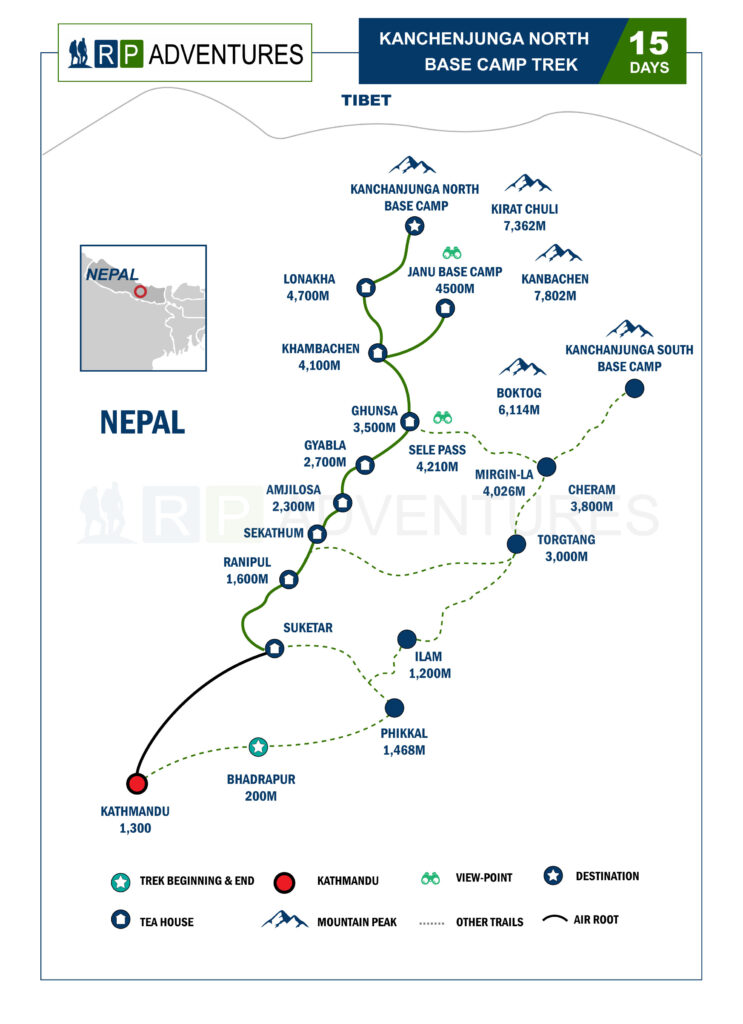
FAQs of Kanchenjunga North Base Camp Trek
-
How difficult is the Kanchenjunga Base Camp trek?
The trek is not particularly hard, but weather conditions can be challenging, especially from Lhonak to North Base Camp, and at Shey La Pass, Mirgin La Pass, and Shey Lapcha Pass due to snow. This is a remote trek where you’ll encounter people at lunch spots and overnight stays. At other times, you’ll follow the banks of Ghunsa Khola (river) and pass by Ramdan Glacier, Kanchenjunga North Glacier, Janu Glacier, and Yalung Khola Glacier. -
Is teahouse trekking possible in the Kanchenjunga region?
Yes, teahouse trekking is possible during the Kanchenjunga trek. You will generally find basic tea houses offering local and organic foods. -
Are there any health care facilities or hospitals along the trekking route?
Yes, there are health posts in Hilllock and Ghunsa villages. In Taplejung, Phungthing Bazaar has a district hospital. -
Can we drink natural drinking water during the trek?
Normally, Himalayan water is not safe to drink directly. It’s advisable to use boiling, water purification tablets, or a water filter to make it safe for drinking. -
Do all cell/mobile phones work during the trek?
Communication via cell or mobile phones can be limited in deep gorges and valleys, but most phones receive signals in higher ridges and hills. Cell phones generally work in towns and villages, and many lodges and shops along the trek offer STD/ISD phones, though they can be expensive due to the remoteness. Internet services may be slow and unreliable in deep gorges and hidden valleys. It’s advisable to carry your own satellite phone for reliable communication. -
How do you reach the Kanchenjunga Base Camp trekking point?
We offer various transportation options for the journey from Kathmandu to different destinations. Travelers can choose from local buses, private transport, regular flights, or helicopter flights. For the local bus option, the journey from Kathmandu to Birtamod takes approximately 10 hours, followed by a 10-hour drive from Ilam to Taplejung, and another 4 hours from Taplejung to Rani Pool. Alternatively, a regular flight from Kathmandu to Birtamod (Bhadrapur) takes around 50 minutes. From there, travelers can hire a private jeep for a 3-hour drive to Ilam, followed by a 7-hour drive to Taplejung and a final 4-hour drive to Rani Pool. Another option is a 1 hour and 15-minute flight from Kathmandu to Suketar, though this service operates twice a week. Upon arrival at Suketar Airport, a 4-hour drive is required to reach Rani Pool. For those opting for a helicopter, the journey from Kathmandu to Suketar takes approximately 2 hours. After reaching Suketar, a 4-hour drive is needed to reach Rani Pool. -
How long does it take to complete both base camp treks?
Normally, the trek takes about 26 days. However, with proper physical and mental preparation, people can complete it in as few as 16 days, depending on their availability. -
How much does the Kanchenjunga Base Camp trek cost?
We offer varying costs depending on individual budgets. Typically, we organize different types of packages ranging from $1,500 to $5,000. -
Can a solo trekker undertake the Kanchenjunga Base Camp trek?
Normally, solo trekking is not allowed in restricted areas. A minimum of two trekkers is required, and the agency arranges the permits with a double permit. You must pay double the permit price to comply with government rules. However, if you adhere to the regulations, you can engage in solo trekking with the assistance of a guide and agency. -
Where are the Kanchenjunga North and South Base Camps located?
Kanchenjunga is located in the eastern part of Nepal, south of Tibet, and north of Sikkim (India). It is situated to the north of the Taplejung district. -
What is the best season to undertake this trek?
Autumn and spring are the best seasons for this trek. Specifically, autumn (October, November, December) and spring (March, April, May) are ideal. -
Which route do climbers mostly follow during the climb?
Climbers typically follow the Kanchenjunga South route, with the South Base Camp known as Yalung Base Camp. -
How high is Kanchenjunga Peak?
The height of Mount Kanchenjunga is 8,586 meters above sea level, making it the third-highest mountain in the world. -
How high is Kanchenjunga North Base Camp?
Kanchenjunga North Base Camp is 5,100 meters high. -
How high Kanchenjunga South Base Camp?
Kanchenjunga South Base camp is 4700 m high. -
Do you know the original name of Kanchenjunga north base camp?
Kanchenjunga North base camp is called Pang Pemba base camp. -
Do you know the original name of Kanchenjunga south base camp?
Kanchenjunga South base camp is called Yalung (bar) base camp. -
How wild is this trek?
Trekking to Kanchenjunga North and South Base Camps is known as a wild trek, as it involves navigating through dense jungle throughout the journey. -
What types of animals can be found during the trek?
In the region, you can encounter various animals such as cows, pigs, goats, yaks, naks, monkeys, red pandas, snow leopards, Himalayan black bears, brown bears, musk deer, blue sheep, sheep, and other mammalian species. -
Which river and lake can be found during the trek?
When we begin the trek, we follow the Tamor River. After crossing the Olangchung Khola, we then follow the Ghunsa Khola. -
Is helicopter tour possible to do this trek?
Yes, it is possible, but it depends on the weather. You need to obtain a special permit, present it during immigration, and seek permission from civil aviation before you can fly. -
In case of the emergency what possibility have in this trek?
In emergency cases, primary treatment is typically administered first. Subsequently, an assessment of the condition is made, and depending on the severity, the individual may be transported via helicopter rescue or carried to a hospital in Taplejung, Birtamod or Kathmandu. -
What types of flower and plant we see during the trek?
During the Kanchenjunga trek, you may encounter a rich variety of flora. Alpine and sub-alpine regions feature rhododendrons, orchids, primulas, and gentians. Lower elevations showcase lush forests with birch, oak, and bamboo. The diverse landscape hosts a myriad of wildflowers, adding vibrant colors to the breathtaking scenery. -
Do we cross the passes during both base camp trek?
Yes, we cross a challenging pass, Lumbasumba. Nowadays, we use alternative passes like She Le Le Pass (4200m), Mirgi la Pass (4700m), and Shey Lapcha Pass (4900m). -
What documents are required for the trek?
We require a valid visa copy, original passport, 4 passport-size photos, Kanchenjunga Special Permit, Kanchenjunga Conservation Permit, and guide insurance from a government-licensed trekking agency. -
Is Ghunsa a big village and do they have a school?
Yes, it is a large village with 100 houses, inhabited by Sherpa people. The village has one secondary school, which is operated jointly by the Nepal government and an NGO. -
How high is Janu (Kumbakarna) Base Camp?
Janu Base Camp is 4500m above the sea level. -
What it is called the Kiranti temple?
People called Kiranti temple as “Phung Thung”. -
What religious and culture do people follow of this region?
People in this region follow various religions, including Animism, Hinduism, Buddhism, Kiranti, and Christianity. -
How is the lifestyle of local people?
The local people lead a simple and basic lifestyle, lacking extensive education. They rely on subsistence farming, cultivating cardamom as a primary cash crop. Additionally, they engage in animal husbandry, raising cows, yaks, and naks. The cultivation of Himalayan herbs is also part of their agricultural practices. -
Is it busy trekking route?
No, it is not very busy, making it ideal for those who wish to undertake a nature and wildlife trek on their own. -
Do wild animals attack the trekker during the trek?
Yes, sometimes Himalayan black bears may attack trekkers and local people as well. -
Do trekkers lost their way during the trek?
Yes, sometimes trekkers and guides may struggle to find the proper way, resorting to following animal paths in the vast and unfriendly jungle. -
Why RP Adventures Different then others?
RP Adventures offers an exclusive and high-end trekking experience with its expensive packages. The allure lies in the luxurious accommodations, highly qualified and experienced guides with excellent educational and medical training, ensuring a safe and enriching journey. Private ground transportation adds to the comfort, while the option of helicopter sharing for aerial transport, especially in remote areas, enhances the adventure. The commitment to quality services and safety justifies the elevated cost, providing clients with a truly premium and unforgettable trekking and tour experience. -
How much tips need to be given to the guide and porter?
Normally, different organizations have different rules. In our organization, we advise allocating 10% of your full package for the guide and 5% for the porter.
Trip You May Like
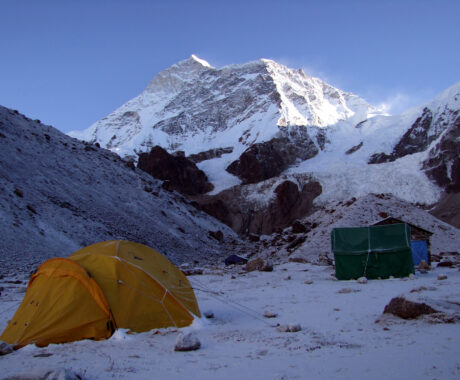
Makalu Base Camp Trek
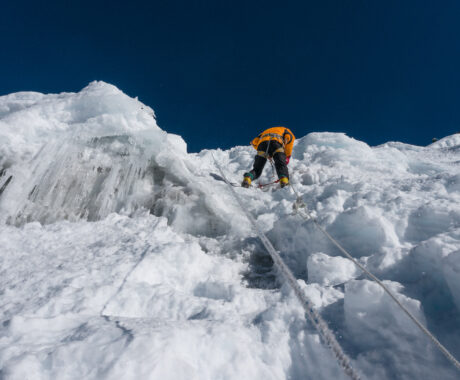
Island Peak & Everest Base Camp Trek
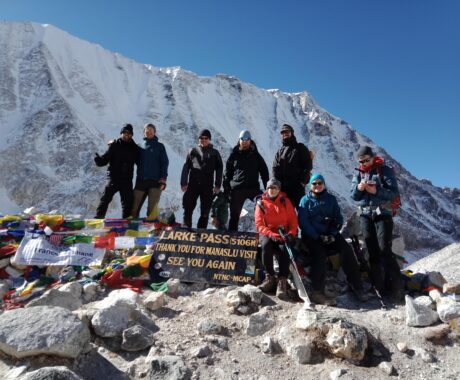
Manaslu Circuit Trek
